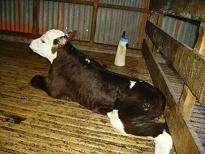Just another brain-damaged Hereford

56 with her new calf. Although most calves would be holding their head up shaking the water out of their ears at this stage, I didn't notice anything wrong with this one.
Until the afternoon when he was still, at about six hours old, unable to stand. He was given a lift to the calfshed and, after 56 was milked, lifted to his feet. I've seen many calves over the years that don't stand on their first day, and almost always the problem is contracted tendons which gradually improves, and by about four days they're on their feet like normal calves. This fellow doesn't have a problem with his legs though. He's swaying on his feet almost toppling over, then every few seconds he swings suddenly the other way, a start as if he's just woken up, or is belatedly trying to balance.
This calf has zero sense of balance.
He collapses gracefully to the floor as soon as he is allowed to fall, and is bottle-fed while sitting up. Twice a day this is repeated - the calf is lifted to his feet and assisted to stand. On his own, he tries and tries to get up and flops around the floor. By two days old there is no improvement, and I'm starting to consider that his future is going to involve a deep hole in the earth. Then that evening his balance seems marginally improved - so good in fact, that he sucks his bottle while standing as I only need to hold a hand on his side to keep him from toppling over.

That's around the time this photo was taken. Ready for his feed, he struggles valiantly to rise alone.
By four days old he has mastered the art of 'crawling', using his front legs to pull himself around while the back ones paddle along behind.

On day five I helped him to stand and gave him his bottle, then walked away from him and left him standing unassisted for the first time.
Of course there had to be a photo of the momentous occasion.

And here he is just looking cute.
The following morning when I turned up with his feed he stood up on his own. By the next day he had taken his first steps - lurching, unbalanced ones, but good enough to allow him to move around the pen with his legs straight, rather than the close to the floor crawling position he adopted formerly.
This morning I put two younger calves in with him (so that I could concentrate on teaching the younger still calves to drink without getting head-butted) and he drank with them from the teated bucket instead of getting his own bottle. At nine days old, he is fully mobile but doesn't yet look normal - his hind legs curve outwards, making him appear much shorter than he actually is and his walk is still ungainly.
He's holding his own well with the other calves.
At this stage, I've lost count of the number of brain-damaged Herefords I've seen this season. As soon as AB finished and the Herefords started arriving I noticed that they took about twice as long as the dairy calves - 4 to 6 feeds rather than two or three - to get to the stage where you could put the milk in front of them and leave them to feed on their own.
Then a calf that had been delayed going on the bobby truck because of a slight scour suddenly lost the ability to stand and showed signs of brain damage (CCN/lead poisoning symptoms - neck straight up, blindness). By then he was over a week old. He caught the slink truck the next day.
A pretty little heifer, twice as heavy as she looked (I carried her in from the paddock) lay on the floor for two days while the other calves stumbled over her before she successfully found her feet and was able to join the others at the communal feeder and a few days later, on the bobby truck.
Seven late calves one day, including a set of twins and by morning the little bull twin had developed a scour and lost the ability to stand. Too busy to even wonder what had happened, I ensured he caught the next slink truck.
This morning another Hereford, walked all the way home yesterday but by nightfall was too weak to stand and refusing to feed. He left life unassisted during the night.
For the first few weeks I figured the slowness to catch on to life was a trait of the breed, but I mentioned it to a vet who didn't think so, voicing the possibility of BVD infection at a critical stage of these calves' development.
Thus far, four brain damaged calves and 56's calf may be the first of those to leave the farm alive. At least half of the remaining calves remarkably slow. The cause may never be known, but I doubt I'll ever have a Hereford bull anywhere near the cows again.



1 Comments:
very nice - you got yourself a digital camera or something?
and how many blogs have you got now? yours'll be perfect for anyone doing research on cows.
see ya
Post a Comment
<< Home